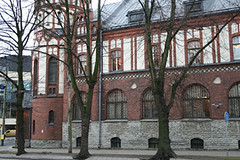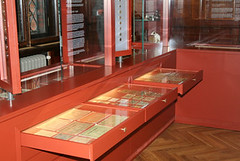
PREV ARTICLE
NEXT ARTICLE
FULL ISSUE
PREV FULL ISSUE
THE BANK OF ESTONIA MONEY MUSEUM
Michael Alexander published a nice article in Coin Update about the Bank of Estonia money museum. Here are some excerpts.
-Editor
I had visited the Bank of Estonia's money museum some years ago when the premises occupied a much smaller space and the exhibitions were limited to that specific confine. Even then, the displays were well done, informative and they managed to put on show some extraordinary artifacts and items which were indeed fascinating and quite fascinating… real museum quality objects in a small central bank museum. At the end of 2010, the Bank of Estonia carried out extensive renovations where the new museum would both increase in size and the premises would now integrate greater portions of the old Estonian Nobility's Credit Union, a landmark building adjacent to the Bank of Estonia's main premises. After more than a year's careful restoration, the new museum was opened in January of this year and, I can say first-hand, the wait was well worth it. I was truly impressed with the restorative work carried out on the interior of the building itself with careful detail paid to the original marble and wood fixtures. The tower and spiral entrance itself is something to see with its stained glass windows (which miraculously survived the Soviet air-raids in 1944) depicting cultural life in the countryside and the hand-painted murals of national crests and emblems - also painstakingly restored.
These printing plates went on display after they were un-earthed in a special exhibition in 2002 and I had the opportunity to review the new addition shortly after their initial debut. Dated with their year of their intended issue of 1940, the plates were used for an initial print run but, these notes were never used and eventually all Krooni notes of that era were withdrawn and forcibly exchanged for USSR roubles. I am told that the Bank never discovered who the loyal Bank employee was who had heroically hid the printing plates for their eventual and hoped-for later use. The plates now form part of the permanent displays of the bank's exhibition.

For any coin & banknote enthusiast, a visit to the Money Museum is a must-see attraction. Tallinn has emerged as a very exciting and vibrant city who has managed to preserve the character and structure of its colorful Hanseatic & medieval past. As a collector, another reason to visit is the museum's gift shop where you can purchase the latest coins and sets direct at issue prices.
To read the complete article, see:
Estonia's Numismatic Past and Present at the Bank of Estonia Money Museum
(news.coinupdate.com/estonia-numismatic-past-and-present The Numismatic Bibliomania Society is a non-profit organization promoting numismatic literature. See our web site at coinbooks.org. To submit items for publication in The E-Sylum, write to the Editor at this address: whomren@gmail.com To subscribe go to: https://my.binhost.com/lists/listinfo/esylum All Rights Reserved. NBS Home Page Contact the NBS webmaster 
|

